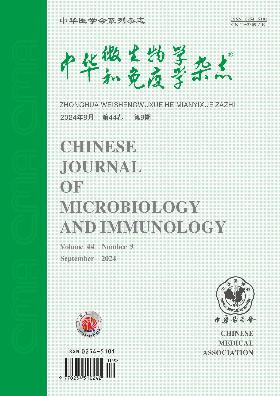结核分枝杆菌PstS1和HspX的免疫反应性及其诊断价值
Q4 Immunology and Microbiology
引用次数: 0
摘要
目的评价重组结核分枝杆菌PstS1和HspX蛋白抗原的体液和细胞免疫反应性,为结核病的免疫诊断和疫苗候选抗原的筛选提供参考。方法采用分子克隆表达和Ni2+亲和层析技术纯化重组结核分枝杆菌PstS1和HspX蛋白。收集健康人群和结核分枝杆菌感染患者的血液样本和流行病学资料。以重组蛋白为抗原,分别采用酶联免疫吸附法(ELISA)和酶联免疫斑点法(ELISPOT)检测特异性IgG抗体和产生IFN-γ的抗原特异性T细胞。统计分析重组PstS1和HspX蛋白的体液和细胞免疫反应性。结果重组PstS1蛋白和HspX蛋白均能诱导结核分枝杆菌感染患者特异性更强的效应T细胞分泌IFN-γ,感染组与健康对照组比较差异有统计学意义(P<0.05)。重组PstS1和HspX作为ELISPOT诊断抗原的特异性和敏感性分别为92.11%(35/38)和65.96%(31/47),68.42%(26/38)和91.49%(43/47)。两种蛋白均具有一定的体液免疫反应性,但两组间仅hspx特异性抗体水平差异有统计学意义(P<0.05)。结论重组PstS1和HspX蛋白均具有良好的细胞免疫反应性,是细胞免疫的免疫优势抗原。它们在细胞免疫诊断中表现良好,是抗结核疫苗的潜在候选抗原。关键词:结核分枝杆菌;PstS1;HspX;Immunodominant抗原本文章由计算机程序翻译,如有差异,请以英文原文为准。
Immunoreactivity and diagnostic value of Mycobacterium tuberculosis PstS1 and HspX
Objective
To evaluate the humoral and cellular immunoreactivity of recombinant Mycobacterium tuberculosis (M.tuberculosis) PstS1 and HspX protein antigens in order to provide reference for immunodiagnosis of tuberculosis and screening of candidates for vaccine antigens.
Methods
Purified recombinant M. tuberculosis PstS1 and HspX proteins were obtained using molecular cloning expression and Ni2+ affinity chromatography. Blood samples and epidemiological data of healthy individuals and patients with M. tuberculosis infection were collected. Specific IgG antibodies and IFN-γ-producing antigen-specific T cells were respectively detected by enzyme-linked immunosorbent assay (ELISA) and enzyme-linked immunospot assay (ELISPOT) with the recombinant proteins used as antigens. The humoral and cellular immunoreactivity of the recombinant PstS1 and HspX proteins were assessed with statistical analysis of data.
Results
Both the recombinant PstS1 and HspX proteins could induce the secretion of IFN-γ by more specific effector T cells in patient with M. tuberculosis infection, and the differences between the infection and healthy control groups were statistically significant (P<0.05). The specificity and sensitivity of the recombinant PstS1 and HspX as the diagnostic antigens of ELISPOT were 92.11% (35/38) and 65.96% (31/47), and 68.42% (26/38) and 91.49% (43/47), respectively. The two proteins also possessed some humoral immunoreactivity, but statistically significant difference was only observed in the HspX-specific antibody level between the two groups (P<0.05).
Conclusions
Both the recombinant PstS1 and HspX proteins had good cellular immunoreactivity and were the immunodominant antigens of cellular immunity. They performed well in cellular immunodiagnosis and were good potential candidate antigens for anti-tuberculosis vaccines.
Key words:
Mycobacterium tuberculosis; PstS1; HspX; Immunodominant antigens
求助全文
通过发布文献求助,成功后即可免费获取论文全文。
去求助
来源期刊

中华微生物学和免疫学杂志
Immunology and Microbiology-Virology
CiteScore
0.50
自引率
0.00%
发文量
6906
期刊介绍:
Chinese Journal of Microbiology and Immunology established in 1981. It is one of the series of journal sponsored by Chinese Medical Association. The aim of this journal is to spread and exchange the scientific achievements and practical experience in order to promote the development of medical microbiology and immunology. Its main contents comprise academic thesis, brief reports, reviews, summaries, news of meetings, book reviews and trends of home and abroad in this field. The distinguishing feature of the journal is to give the priority to the reports on the research of basic theory, and take account of the reports on clinical and practical skills.
 求助内容:
求助内容: 应助结果提醒方式:
应助结果提醒方式:


